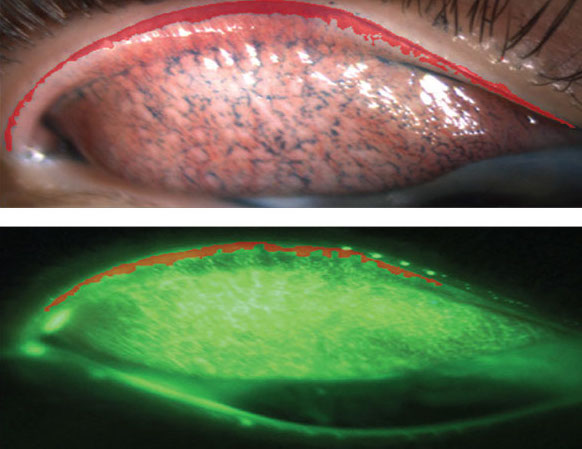 |
| The areas colored in red outline what is considered to be lid wiper epitheliopathy. Photo: Chris Lievens, OD. Click image to enlarge. |
Most patients with dry eye have lid wiper epitheliopathy (LWE)—an epitheliopathy of the marginal conjunctival portion of the eyelids that wipes the ocular surface during blinking—but the factors determining the severity of LWE are unknown. In this study, researchers investigated the relationship between LWE, tear abnormality and blinking in dry eye.
A total of 76 eyes of 76 female patients with dry eye took part in this study. Tear meniscus radius (TMR), spread grade (SG) of the tear film lipid layer, fluorescein breakup time (FBUT), fluorescein breakup pattern, corneal and bulbar conjunctival epithelial damage, upper eyelid LWE grade and Schirmer 1 test were evaluated.
LWE was significantly related to TMR and SG of the tear film lipid layer, which are correlated with tear volume. Additionally, the LWE grade was significantly related to FBUT, which is correlated with tear film stability. These findings indicate that tear volume and tear film stability are important factors in determining the LWE grade, a finding similar to that of previous studies.
No significant relationship was found between LWE grade and blink-related parameters. “However, multiple regression analysis demonstrated that the LWE grade was significantly related to SG of the tear film lipid layer, FBUT and upper eyelid closing phase maximum velocity,” the authors explained. “To the best of our knowledge, this is the first report demonstrating that a dynamic blink factor (i.e., upper eyelid closing phase maximum velocity) is related to the LWE grade.”
In comparison with a previous study, it was found that the LWE grade is determined by similar parameters, and the SG of the tear film lipid layer, FBUT and upper eyelid closing phase maximum velocity were also nearly the same in this study.
“This indicates that not only the determining factors for conjunctival epithelial damage (CjED) in dry eye, but also the contribution of each determining factor for CjED is similar to those for LWE in dry eye,” the authors noted. “Thus, it is speculated that a common mechanism, that of increased friction, which is one of the essential mechanisms for dry eye, is associated with both CjED and LWE.”
It’s worth noting that multiple regression analysis showed that the LWE grade was related to SG of the tear film lipid layer, FBUT and upper eyelid closing phase maximum velocity, making this the first report to demonstrate that a dynamic blink factor is related to the LWE grade.
“Based on these results, LWE can be treated by improving tear volume and tear film stability by using eye drops or punctal occlusion in the clinical setting because the velocity of the upper eyelid during blinking cannot be changed,” the authors concluded.
Kato H, Yokoi N, Watanbe A, et al. Clinical factors for determining the severity of lid wiper epitheliopathy in dry eye. Cornea. October 23, 2021. [Epub ahead of print]. |

